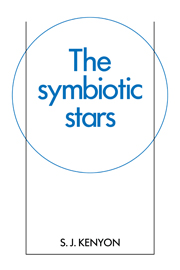Book contents
- Frontmatter
- Contents
- Preface
- 1 Introduction
- 2 The Quiescent Phase - Theory
- 3 The Quiescent Phase - Observations
- 4 The Outburst Phase - Theory
- 5 The Outburst Phase - Observations
- 6 The Formation and Evolution of Symbiotic Stars
- 7 Epilogue
- References to Chapters 1-7
- Appendix
- References to the Appendix
- Subject Index
- Individual Stars
5 - The Outburst Phase - Observations
Published online by Cambridge University Press: 26 May 2010
- Frontmatter
- Contents
- Preface
- 1 Introduction
- 2 The Quiescent Phase - Theory
- 3 The Quiescent Phase - Observations
- 4 The Outburst Phase - Theory
- 5 The Outburst Phase - Observations
- 6 The Formation and Evolution of Symbiotic Stars
- 7 Epilogue
- References to Chapters 1-7
- Appendix
- References to the Appendix
- Subject Index
- Individual Stars
Summary
Introduction
The outbursts of symbiotic stars have generally attracted much attention, and each eruption is a new adventure in complexity. Since the hot component is the source of the instability, observations acquired throughout the event reveal little of the nature of the cool giant star. Indeed, infrared photometry of CH Cyg and CI Cyg suggests the giant maintains a roughly constant luminosity during a complete outburst cycle (Swings and Allen 1972; Szkody 1977; Kenyon and Gallagher 1983; Luud 1980, and references therein). Thus, the giant appears not to play a direct role in the evolution of an eruption, although it certainly has a good view!!
A typical symbiotic eruption commences with a 2-7 mag rise in visual brightness, which is accompanied by remarkable spectroscopic changes (Belyakina 1979). The B-V color decreases from 1.0-1.5 to 0.0-0.6, suggesting that a relatively hot source dominates the light at visual maximum. While the evolution of B-V as a function of V may be similar for nearly all outbursting symbiotic stars, the duration of and the spectroscopic changes observed in a given outburst naturally divide these systems into three distinct groups:
(i) recurrent novae (e.g., T CrB),
(ii) classical symbiotic stars (e.g., CI Cyg), and
(iii) symbiotic novae (e.g., AG Peg; also known as very slow novae).
Representative light curves for each group are shown in Figures 5.1-5.3; the outbursts of the slow nova-like systems require many decades, while those of CI Cyg and other classical symbiotic systems are much more rapid. The eruptions of recurrent novae are extremely rapid, lasting less than a few months.
- Type
- Chapter
- Information
- The Symbiotic Stars , pp. 91 - 114Publisher: Cambridge University PressPrint publication year: 1986



